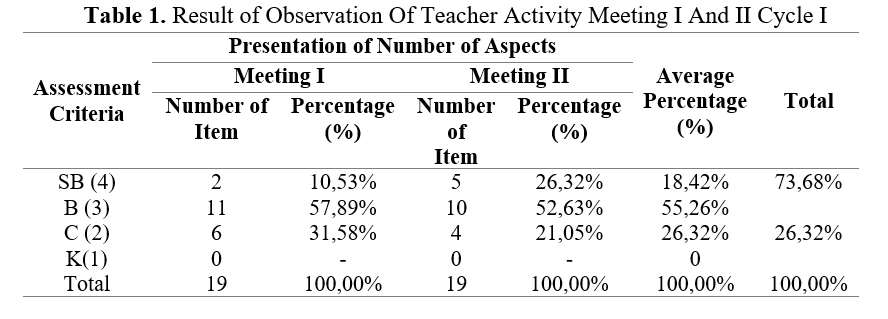Mathematical Reasoning Ability of Junior High School Students: Application of Discovery Learning Model
DOI:
https://doi.org/10.51574/ijrer.v4i3.2951Keywords:
Discovery Learning, Junior High School, Mathematical Reasoning, Learning ModelAbstract
Mathematical reasoning ability is necessary for solving mathematical problems. Therefore, the intent of this study is to enhance students' mathematical reasoning ability through the application of a discovery learning model focused on quadratic function material. This research is Classroom Action Research, designed by Kemmis and McTaggart. The research subjects were 32 students of grade IX at Public Junior High School 1 Tapa. This study used tests for mathematical reasoning, teacher and student activity observation sheets, and questionnaires. The data was analyzed quantitatively and qualitatively using percentages. The findings of this study indicate an increase in students' mathematical reasoning ability after applying the discovery learning model. Teacher activities in cycle I with a percentage of 73.68% increasing in cycle II to 89.47%; student activities in cycle I with a percentage of 72.50% increasing in cycle II to 87.50%; questionnaire results in cycle I only 20 people with a percentage of 62.50% increasing in cycle II to 28 people with a percentage of 87.50%; and the results of students' reasoning ability in cycle I only 23 people with a percentage of 71.87% increasing in cycle II to 28 people with a percentage of 90.62%. There were still 4 people with a percentage of 9.28% who scored <75. In cycle II, the teacher activities, student activities, questionnaires, and reasoning skills met the success indicators.
References
Ariati, C., & Juandi, D. (2022). Kemampuan Penalaran Matematis: Systematic Literature Review. Jurnal Lemma, 8(2), 61–75. https://doi.org/10.22202/jl.2022.v8i2.5745
Bayat, M., Banihashem, S. K., & Noroozi, O. (2022). The effects of collaborative reasoning strategies on improving primary school students’ argumentative decision-making skills. The Journal of educaTional research, 115(6), 349-358. https://doi.org/10.1080/00220671.2022.2155602
Cahyani, N. D., & Sritresna, T. (2023). Kemampuan penalaran matematis siswa dalam menyelesaikan soal cerita. Jurnal Inovasi Pembelajaran Matematika: PowerMathEdu, 2(1), 103–112. https://doi.org/10.31980/powermathedu.v2i1.2720
Castañeda, L. E. G., Sklarek, B., Dal Mas, D. E., & Knauff, M. (2023). Probabilistic and deductive reasoning in the human brain. NeuroImage, 275, 120180. https://doi.org/10.1016/j.neuroimage.2023.120180
Danişman, Ş., & Erginer, E. (2017). The predictive power of fifth graders’ learning styles on their mathematical reasoning and spatial ability. Cogent Education, 4(1), 1266830. https://doi.org/10.1080/2331186X.2016.1266830
Ellis, A., Özgür, Z., & Reiten, L. (2019). Teacher moves for supporting student reasoning. Mathematics Education Research Journal, 31, 107-132. https://doi.org/10.1007/s13394-018-0246-6
Fauziah, N., Sunaryo, Y., & Ruswana, A. M. (2021). Analisis Kemampuan Penalaran Matematis Berdasarkan Gaya Belajar Siswa. J-KIP (Jurnal Keguruan dan Ilmu Pendidikan), 2(3), 119. https://doi.org/10.25157/j-kip.v2i3.6197
Grootenboer, P., Edwards-Groves, C., & Kemmis, S. (2023). A curriculum of mathematical practices. Pedagogy, Culture & Society, 31(3), 607-625. https://doi.org/10.1080/14681366.2021.1937678
Habsah, F. (2017). Developing teaching material based on realistic mathematics andoriented to the mathematical reasoning and mathematical communication. Jurnal Riset Pendidikan Matematika, 4(1), 43-55. https://doi.org/10.21831/jrpm.v4i1.10199
Hasbi, M., Lukito, A., & Sulaiman, R. (2019). Mathematical connection middle-school students 8th in realistic mathematics education. In Journal of Physics: Conference Series (Vol. 1417, No. 1, p. 012047). IOP Publishing. https://doi.org/10.1088/1742-6596/1417/1/012047
Hasbi, M., Lukito, A., Sulaiman, R., & Muzaini, M. (2019). Improving the mathematical connection ability of middle-school students through realistic mathematics approach. Journal of Mathematical Pedagogy (JoMP), 1(1), 37-46. https://doi.org/10.26740/jomp.v1n1.p37-46
Jeannotte, D., & Kieran, C. (2017). A conceptual model of mathematical reasoning for school mathematics. Educational Studies in mathematics, 96, 1-16. https://doi.org/10.1007/s10649-017-9761-8
Julfianto, M., Suanto, E., & Siregar, S. N. (2022). Developing Problem Based Learning Device to Grow Students' Mathematical Critical Thinking Ability. Jurnal Gantang, 7(2), 173-184. https://doi.org/10.31629/jg.v7i2.5318
Kilpatrick, J. (2020). Competency frameworks in mathematics education. In Encyclopedia of mathematics education (pp. 110-113). Cham: Springer International Publishing. https://doi.org/10.1007/978-3-030-15789-0_27
Kusumah, H., Maspupah, M., & Mas’ud, A. (2023). Respon Siswa Terhadap Model Pembelajaran Discovery Learning Berbantu Wordwall Pada Materi Sistem Pertahanan Tubuh. In Gunung Djati Conference Series (Vol. 30, pp. 66-71). https://conferences.uinsgd.ac.id/index.php/gdcs/article/view/1838
Listyotami, M. K., Noer, S. H., & Haenilah, E. Y. (2018). Discovery learning to develop student reflective thinking ability and self-efficacy. Al-Jabar: Jurnal Pendidikan Matematika, 9(1), 73-84. https://doi.org/10.24042/ajpm.v9i1.2839
Maass, K., Geiger, V., Ariza, M. R., & Goos, M. (2019). The role of mathematics in interdisciplinary STEM education. Zdm, 51, 869-884. https://doi.org/10.1007/s11858-019-01100-5
Mendrofa, N. K., & Mendrofa, R. N. (2022). Pengaruh Model Pembelajaran Discovery Learning dengan Pendekatan Saintifik terhadap Kemampuan Penalaran Matematis Siswa SMP. Jurnal education and development, 10(2), 535-537. https://journal.ipts.ac.id/index.php/ED/article/view/3782
Muhammad, I., & Juandi, D. (2023). Discovery Learning Research in Mathematics Learning (1968-2023): A Bibliometric Review. Hipotenusa: Journal of Mathematical Society, 5(2), 197-214. https://doi.org/10.18326/hipotenusa.v5i2.396
Mukuka, A., Balimuttajjo, S., & Mutarutinya, V. (2023). Teacher efforts towards the development of students’ mathematical reasoning skills. Heliyon, 9(4). https://doi.org/10.1016/j.heliyon.2023.e14789
Muslimin, M., & Sunardi, S. (2019). Analisis kemampuan penalaran matematika siswa sma pada materi geometri ruang. Kreano, Jurnal Matematika Kreatif-Inovatif, 10(2), 171-178. https://doi.org/10.15294/kreano.v10i2.18323
Olsson, J., & Granberg, C. (2024). Teacher-student interaction supporting students’ creative mathematical reasoning during problem solving using Scratch. Mathematical Thinking and Learning, 26(3), 278-305. https://doi.org/10.1080/10986065.2022.2105567
Permana, N. N., Setiani, A., & Nurcahyono, N. A. (2020). Analisis kemampuan penalaran adaptif siswa dalam menyelesaikan soal Higher Order Thinking Skills (HOTS). Jurnal Pengembangan Pembelajaran Matematika, 2(2), 51-60. https://doi.org/10.14421/jppm.2020.22.51-60
Prastika, K. Y., Abbas, N., Ismail, Y., & Majid, M. (2023). Meningkatkan Hasil Belajar Matematika Menggunakan Model Penemuan Terbimbing Materi Persamaan Garis Lurus Kelas VIII. Innovative: Journal Of Social Science Research, 3(2), 13917-13932. http://j-innovative.org/index.php/Innovative/article/view/1998
Pratama, A., Fazera, D., Fortunata, L. A., Manurung, N., & Fadilah, R. (2024). Penerapan Model Pembelajaran Discovery Learning untuk Meningkatkan Hasil Belajar Siswa. Jurnal Inovasi Pendidikan, 2(1), 21–31. https://doi.org/10.60132/jip.v2i1.190
Putri, D. K., Sulianto, J., & Azizah, M. (2019). Kemampuan penalaran matematis ditinjau dari kemampuan pemecahan masalah. International Journal of Elementary Education, 3(3), 351-357. https://doi.org/10.23887/ijee.v3i3.19497
Rahman, L., Fitraini, D., & Fitri, I. (2019). Pengaruh penerapan model discovery learning terhadap kemampuan penalaran matematis ditinjau dari pengetahuan awal siswa SMP Negeri 3 Tambang Kabupaten Kampar. JURING (Journal for Research in Mathematics Learning), 2(1), 001-010. http://dx.doi.org/10.24014/juring.v2i1.7467
Rahmawati, K. D., & Astuti, D. (2022). Kemampuan Penalaran Matematis Siswa SMA pada Materi Pertidaksamaan Dua Variabel. Plusminus: Jurnal Pendidikan Matematika, 2(2), 187–200. https://doi.org/10.31980/plusminus.v2i2.1763
Rismen, S., Mardiyah, A., & Puspita, E. M. (2020). Analisis kemampuan penalaran dan komunikasi matematis siswa. Mosharafa: Jurnal Pendidikan Matematika, 9(2), 263-274. https://doi.org/10.31980/mosharafa.v9i2.609
Rott, B., & Rott, B. (2021). Inductive and Deductive Justification of Knowledge. Epistemological Beliefs and Critical Thinking in Mathematics: Qualitative and Quantitative Studies with Pre-Service Teachers, 121-145. https://doi.org/10.1007/978-3-658-33539-7_6
Sary, R. F., Juandi, D., & Jupri, A. (2022). Model Pembelajaran Discovery Learning Dan Kemampuan Penalaran Matematis. AKSIOMA: Jurnal Program Studi Pendidikan Matematika, 11(2), 1028. https://doi.org/10.24127/ajpm.v11i2.4765
Simamora, R. E., & Saragih, S. (2019). Improving Students' Mathematical Problem Solving Ability and Self-Efficacy through Guided Discovery Learning in Local Culture Context. International Electronic Journal of Mathematics Education, 14(1), 61-72.
Siregar, N. C., Rosli, R., & Maat, S. M. (2020). The effects of a discovery learning module on geometry for improving students' mathematical reasoning skills, communication and self-confidence. International Journal of Learning, Teaching and Educational Research, 19(3), 214-228. https://www.ijlter.net/index.php/ijlter/article/view/414
Sopwatillah, S. (2021). Meningkatkan Kemampuan Penalaran Matematis Siswa Melalui Pembelajaran Berbasis Masalah Materi Peluang Kelas Xi Tkro-a Smkn 4 Jakarta. VOCATIONAL: Jurnal Inovasi Pendidikan Kejuruan, 1(4), 210–220. https://doi.org/10.51878/vocational.v1i4.739
Sutrisno, S. (2019). Meningkatkan Hasil Belajar Siswa Melalui Pembelajaran Dengan Model Discovery Learning Pada Siswa Kelas X MIPA 5 SMA N 1 Bantul Tahun Pelajaran 2018/2019. Ideguru: Jurnal Karya Ilmiah Guru, 4(1), 58-71. https://doi.org/10.51169/ideguru.v4i1.69
Verschaffel, L., Schukajlow, S., Star, J., & Van Dooren, W. (2020). Word problems in mathematics education: A survey. Zdm, 52, 1-16. https://doi.org/10.1007/s11858-020-01130-4
Vos, P. (2018). “How real people really need mathematics in the real world”—Authenticity in mathematics education. Education Sciences, 8(4), 195. https://doi.org/10.3390/educsci8040195

Downloads
Published
How to Cite
Issue
Section
License
Copyright (c) 2025 Andika Prasetyo Mokoginta, Evi P. Hulukati, Putri Ekawaty Kobandaha

This work is licensed under a Creative Commons Attribution-ShareAlike 4.0 International License.









1.png)













